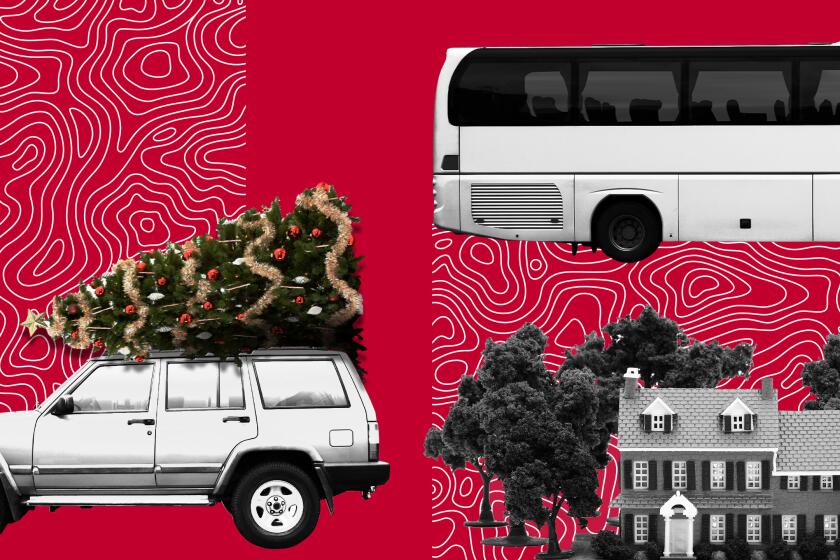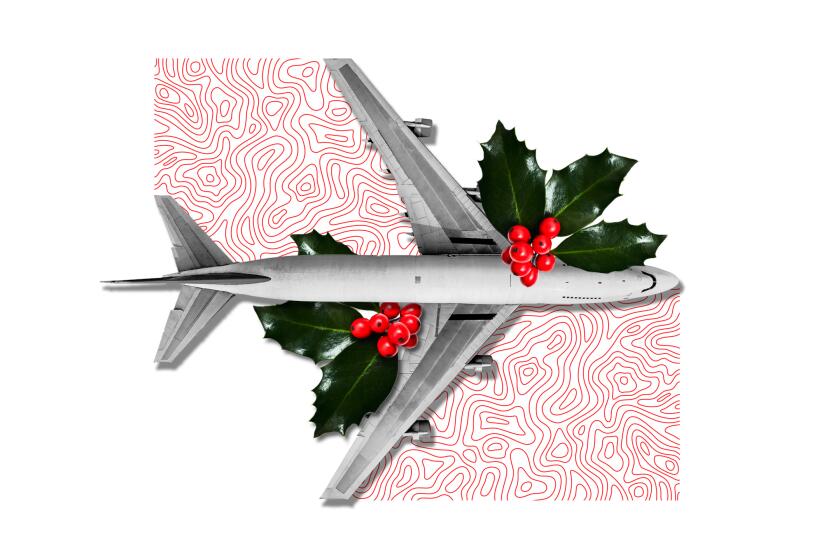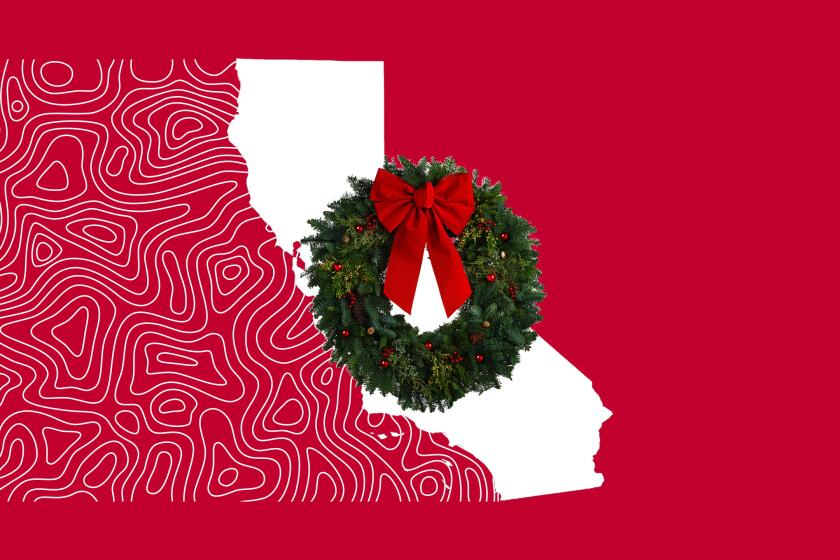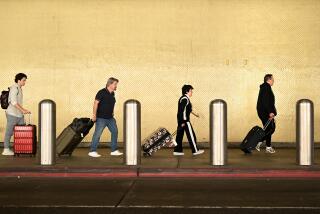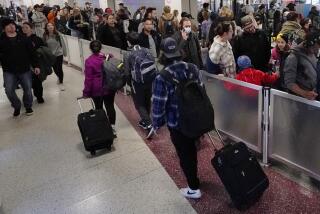If you must travel over Thanksgiving, here is how to minimize your COVID-19 risk
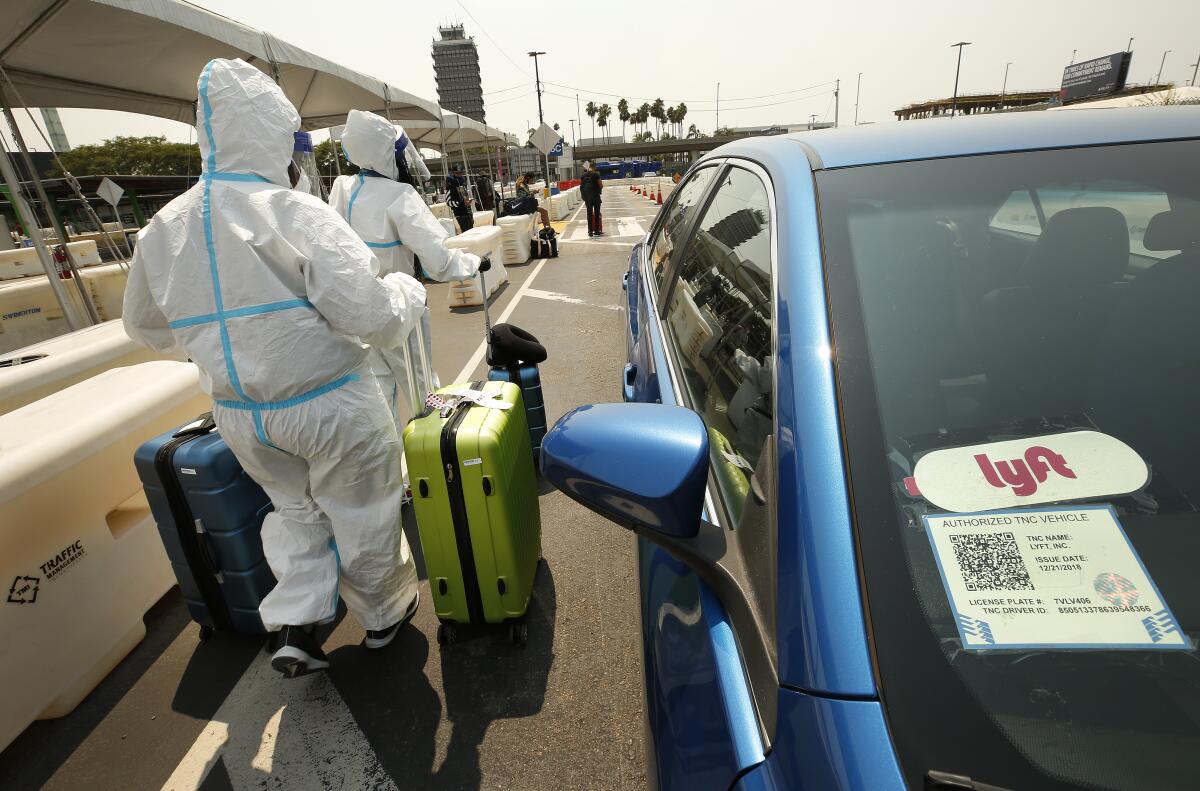
- Share via
SAN FRANCISCO — Determined to travel for Thanksgiving?
Doing so increases your risk of being exposed to the coronavirus and of possibly spreading it to others, experts warn. Nonetheless, millions of Americans are expected to take to the skies for the holiday. Although it marks a 48% decline from last year, AAA estimates that 2.4 million Americans will still travel by air for Thanksgiving. An additional 48 million people will travel by car, a 4% drop.
Health officials across the country are urging people to avoid nonessential travel.
“We’re actually recommending this Thanksgiving be a stay-at-home Thanksgiving,” said Barbara Ferrer, the L.A. County director of public health. “If you are going to travel, we do ask when you come back that you quarantine for 14 days.”
Gov. Gavin Newsom echoed that plea on Friday, urging Californians to not travel out of state and to quarantine if they do.
“Travel increases your chance of getting and spreading COVID-19. Staying home is the best way to protect yourself and others from COVID-19,” the U.S. Centers for Disease Control and Prevention says on its website.
How to travel this holiday season by plane, train and car, and how to safely stay in a hotel or a rental. If you’re staying local, we have ideas for how to spend the time.
There’s reason to be concerned: Early this year in China, a large spike in travel around the Lunar New Year holiday accelerated the spread of the coronavirus throughout the country and beyond its borders.
Here in the U.S., coronavirus cases are rising significantly, at rates not seen previously in the pandemic. “The more cases at your destination, the more likely you are to get infected during travel and spread the virus to others when you return,” the CDC cautions.
Airports, train stations and rest stops are places where people are at risk of being exposed to the virus and it can be difficult to stay six feet away from others, as health experts strongly recommend. At airports, for example, travelers must wait in security lines and gather at gates before boarding their planes.
Once on a plane, where you sit matters. “There’s actually research on this, believe it or not: You want to sit at the window,” Dr. George Rutherford, epidemiologist and infectious diseases expert at UC San Francisco, said during a recent campus town hall. “And you want to sit as far away from the toilets as much as possible, which would minimize how often you’re near passengers walking past you...You want to be as far away from that action as possible.”
Rutherford also recommended choosing airlines that are not selling the middle seats in rows to increase distancing between passengers. “I think that’s important,” he said.
“Most viruses and other germs do not spread easily on flights because of how air circulates and is filtered on airplanes,” the CDC says. “However, social distancing is difficult on crowded flights, and sitting within six feet of others, sometimes for hours, may increase your risk of getting COVID-19.”
Airplane fares are rising, middle seats are filling up and the number of people flying has nearly doubled since June. Here are things to know if you’re traveling by plane.
If you find yourself needing to take a taxi or rideshare, the CDC recommends to avoid riding with unmasked drivers or passengers; avoid touching surfaces; don’t accept free water bottles; sit as far as possible from the driver; and ask the driver to improve ventilation by opening the windows or setting the air ventilation system on non-recirculation mode, the agency said.
Bay Area health officials took an even stronger stance about car travel, saying in a statement: “Don’t share vehicles with people you don’t live with. Vehicles are small enclosed spaces where COVID-19 can spread easily between people.
“If you must share a vehicle, try to ride with the same people each time, make sure everyone wears a face covering and open the windows to maximize outdoor air circulation as much as you can,” Bay Area health officials said in a joint statement.
Those taking public transit should avoid touching surfaces, travel during non-peak hours and stay at least six feet from other travelers whenever possible. “Stay out of crowded spaces when possible, especially at transit stations and stops,” the CDC says.
Rutherford also suggested that college students not return home for the holidays this winter. But if that’s not possible, he suggested having them get tested before they depart and tested again at home with about three days between tests.
“One single test is not going to do it. You got to get tested twice,” Rutherford said.
With care, you can reduce the risks that come with spending a night in a hotel or motel. Use these tips when choosing a room and for when you arrive at your destination.
A single negative test is not proof that someone is not infected. If a person is tested shortly after becoming infected and before the virus has reproduced enough copies of itself, a test could fail to detect the virus and produce a false negative result.
At the University of Notre Dame in Indiana, campus officials voiced dismay at students swarming the football field to celebrate an upset victory over Clemson University. The university is now mandating that students get tested for the virus before returning home at the end of the semester and are threatening to tie up the students’ registration for the next semester if they don’t get tested before leaving the campus near South Bend, Ind.
“You may not leave the South Bend area until you receive the results of your exit test,” the campus said.
“Obviously, the preference is for people not to be flying home for the holidays — for students or for others — at this point in time,” said Ferrer, the L.A. County director of public health.
She said that some colleges are recommending that if students do return home for Thanksgiving, they stay home for the rest of the year and finish up the rest of the semester remotely online “so that you’re not really exposing lots more people when you come back ... to finish out the semester.”
The L.A. County recommendation to quarantine for 14 days when returning from travel means staying at home as much as possible, and not leaving to go to the grocery store or to restaurants. Instead, people in quarantine should order food to be delivered, Ferrer said.
So you’re not traveling for the holidays. Here’s what to do in Southern California, including where to hike, play in the ocean and spend a day trip.
During quarantine, you can go out for a walk by yourself, said Ferrer, as long as you don’t come in contact with other people. “We don’t want you go to restaurants and sitting and eating outside. And we don’t want you going into retail establishments, either, when we’ve asked you to quarantine.”
“The tighter you can restrict your activities over those 14 days, the better off we all are,” Ferrer said.
Similarly, health officials in the Bay Area strongly recommend self-quarantining for 14 days after returning to the region if a traveler’s activities put them at higher risk for infection. That can include traveling on planes and other public transit where face masks were not worn at all times by everyone or being within six feet of people outside your nuclear family if anyone was not wearing a mask.
More to Read
Sign up for Essential California
The most important California stories and recommendations in your inbox every morning.
You may occasionally receive promotional content from the Los Angeles Times.
